Cyber Corner
So You Want To Be A Cartoonist!
Part I of A Step-By-Step Guide
to Computer Cartooning
BY MARCUS BADGELEY
 |
 |
| Figure 1. | Figure 2 |
"Why don't you go out and get a respectable job like a doctor or lawyer, something that makes some money?" That's what they say.
The pull towards cartooning is not something I can readily put into words. Strange and wondrous images float or scamper through my cerebral chambers, talking in tweaked-up voices about dramatic, yet silly issues with no purposes other than to make people laugh, ponder in dumbfounded amazement or escape reality momentarily.
You'll know you've got the itch when you can feel your cartoon creations and hear their funny voices. At times it's like Mel Blanc living inside you. Actually, "Who Framed Roger Rabbit?" has come the closest to capturing the spontaneous hilarity and childlike joy of living with 'Toons, except that in our real world, it all happens inside our heads.
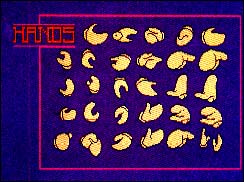 |
If you're serious about cartooning, one approach is to use a graphic data- base consisting of different parts of your characters, such as the Besch- noone Bits in Figures 1-4. |
| Figure 3 | |
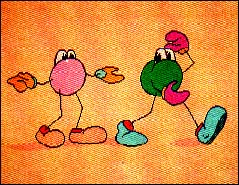 |
|
| Figure 4 | |
I set forth upon quite an expedition when I bought my ST three years ago. I've spent enormous amounts of time learning to convert hand-drawn images--to me, intrinsically more "natural" into a form which works only in straight lines and geometric shapes, not to mention the other obvious limitations, such as limited resolutions and palettes.
When I first started drawing on the ST, I found that creating an image on the computer took a great deal longer than doing it by hand, destroying the myth that computers are time-savers. The question for me was, and still is: "How can I create images to be as 'real' as possible on the computer--and as quickly as possible?"
In this series, I'll describe some of the basic techniques I've discovered to create cartoon images. I hope that these tips prove useful for the first-time cartoonist and seasoned professional alike.
A Good, Quick Tip
Because of my own drawing style, I am very particular as to how "natural" lines look on the computer; I'll spend a lot of time getting a line to look exactly right.
I think the first shortcut I found to approach the kind of line I wanted was to use the connected line function found in paint programs, rather than drawing free-hand with the mouse (In DEGAS Elite, the connected line mode is called K-Line; in Cyber Paint, you must select Line from the Draw Menu and Connected from the Mode menu.) By simply moving the mouse along a desired arc and pressing the mouse button in rapid succession, I was able to get a line that required less magnified reworking. Because of the low resolution of the Atari screen, exact pixel placement really makes a difference; that's why I use a magnified mode ("Zoom") to touch-up almost everything I do.
Techniques
Imagine that it's early in the day and I walk into my studio and sit down in front of my computer. I feel the urge coming on and a silly, crazed grin comes over my face. And then I hear high, whiny voices inside me pleading to "Let 'em out!" At this point I know what I have to do and I have several choices how to create the image that beckons to me.
First of all, I can create an image from scratch in the computer. This method usually takes the most time, depending on the image and detail.
The second option is to create a database of characters. This is useful only after I've already created several images. It requires an initial investment of time, but is so quick and easy to use thereafter. Look atFigures 1through 4, where I've pasted different parts of my old "Beschnoones" characters into a graphic database that I can use to create new characters.
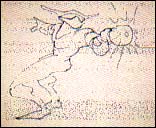 |
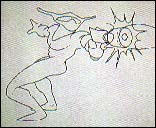 |
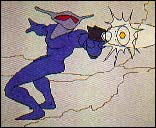 |
| Figure 5 | Figure 6 | Figure 7 |
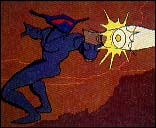 |
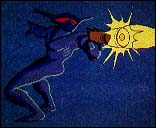 |
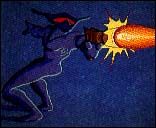 |
| Figure 8 | Figure 9 | Figure 10 |
| In case you're more comfortable drawing on paper than an the screen, Figures 5-10 show how an original drawing was scanned with a digital scanner, cleaned up in DEGAS Elite and then imported into Unispec. | ||
The third technique--my favorite--begins by drawing the image by hand on paper and then scanning it into the computer. I then rework it in whichever art program seems appropriate for the type of image I'm looking for. I've been using the Seymor-Radix scanner which works moderately well. (I hear that the recent update works even better.) I find that this method recreates themovement--the feeling of life--in a paper-drawn image better than I can create it in the computer.
In Figures 5 through 10, you'll see a step-by-step example of this scanning technique. This image was scanned in, cleaned up in DEGAS Elite and then imported into Unispec.
A fourth option is to design characters in CAD-3D, paste them to a background and then rework the images as needed in a paint program. Doing it this way means that a character can be shown from any angle and in any lighting. Since I have almost no experience with the CYBER family (except for Cyber Paint), I won't show any examples; however it is conceptually sound.
Keep in mind that there are no rules for the process of creation and you can intermix these methods as you choose. The only rule--which is actually a nonrule--is "If it works, use it."
A Philosophical Note
In terms of the deeper, more serious issues, I believe that for a cartoon image to work, it must be grounded in reality to some degree. Just as the Old Masters did, a cartoonist should begin by working from nature, gaining as much drawing experience as possible. Then the cartoon images and forms that come later will be more believable and convincing.
Next column, we'll look at a technique for creating cartoon faces that's so simple that any beginner can do it. In the following column, we'll focus on scanning and throw in a few other tips to make your cartooning life easier.
Marcus Badgeley is the owner and director of Gravity Design, a graphic design studio in San Francisco.
PRODUCTS MENTIONED
DEGAS Elite, $49.95. Electronic Arts, 1820 Gateway Drive, San Mateo, CA 94404, (415) 571-7171.
Cyber Paint, $79.95. Antic Software, 544 Second Street, San Francisco, CA 94107, (800) 234-7001.
Seymor-Radix scanner, $99.95. Seymor-Radix, P.O. Box 166055, Irving TX 75016, (214) 823-5797.